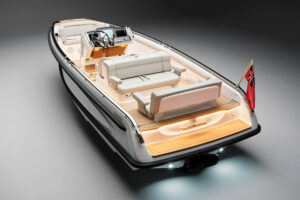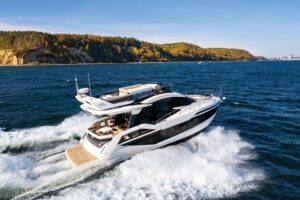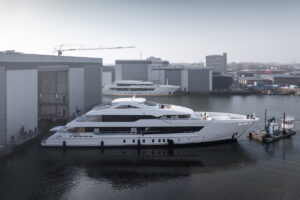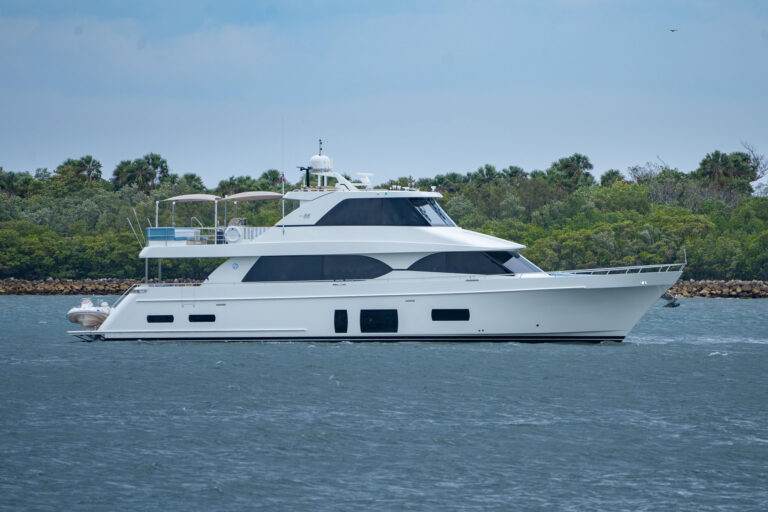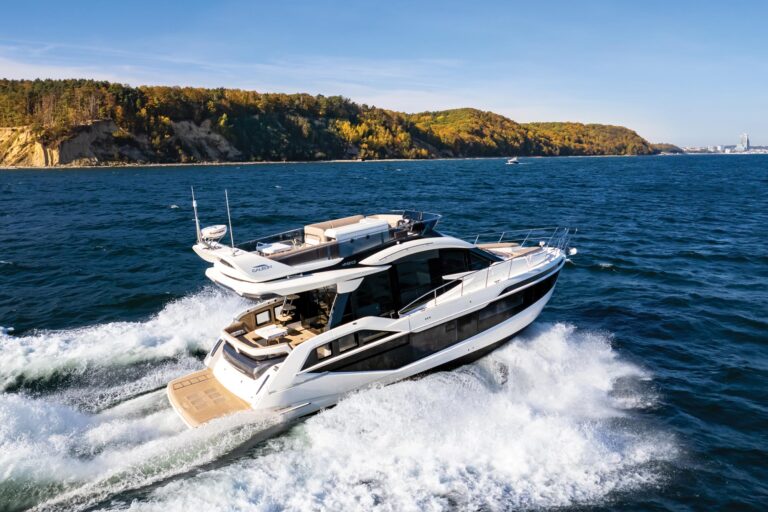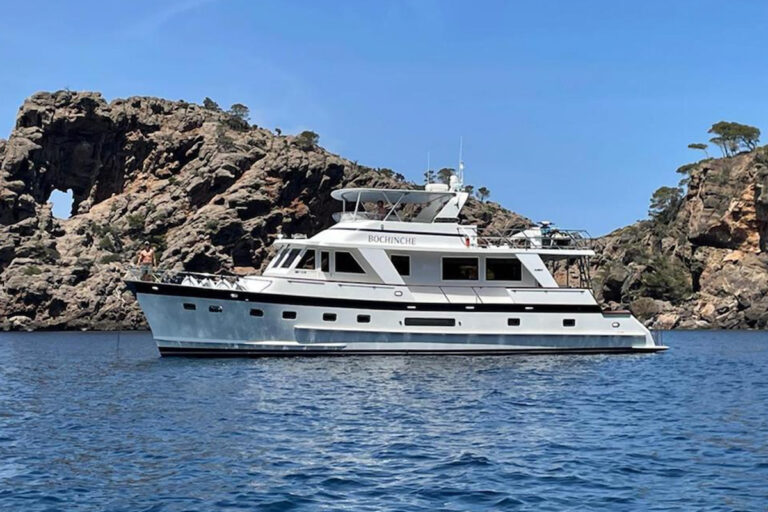The rhythm of yacht sales has a tendency to rise and fall like the Dow, but custom sportfish builders have managed to maintain a steady chart, most by abandoning smaller models over the years.
Jarrett Bay Boatworks, on the other hand, is striving to offer serious fishermen a serious ride with the new 38 Express Sportfisherman. Our test boat-one of the finest sea boats I have run in the class-was nimble and quick through the calm waters of North Carolina’s Bogue Sound and in a sloppy, 4-foot sea in Beaufort Inlet. Her running surface sports clean lines, and her lightweight structure and balance deliver a superior ride.
The Jarrett Bay 38 also stands out in quality and technique, influenced by the tradition of boatbuilding in the Outer Banks of North Carolina, where hull forms and construction techniques have evolved from the commercial and charter fisheries. Treacherous shallow inlets and fickle sea conditions have defined design, and the 38 is built to handle both.
She is cold-molded, like most custom-built tournament fishing boats. Not wishing to weigh in on the debate surrounding wood’s advantages in raising fish, I can confirm that modern cold-molded construction is excellent for lightweight, high-speed vessels. Our performance numbers were in line with expectations, but bottom fouling left our test boat’s 450 hp Cummins short a few turns. Jarrett Bay’s numbers indicate a solid 30-knot cruise at 2400 rpm and a 33.5-knot top speed with a tower and half-load.
The 38’s hull is laminated with three layers of fir and mahogany that is diagonally laid, epoxy glued and screwed. The hull shell is supported with marine plywood bulkheads and web frames, as well as a laminated fir stringer system. A layer of biaxial fiberglass reinforcement with epoxy covers the hull’s interior and exterior surfaces, and all surfaces are finished with a linear polyurethane coating. The superstructure is built in similar fashion, and honeycomb coring is used for nonstructural interior bulkheads and the larger portions of the cabinetwork.
Jarrett Bay’s cold-molded construction scantlings are consistent with those of other builders, but I was impressed with the efficiency of the builder’s method. Modular construction is used for superstructures and portions of the joinery, allowing the yard to work on the components during hull construction. Additional time and cost are saved in fitting out, as all aluminum work, including the beautifully sculpted engine foundations, the fuel tank and the anodized tower, are fabricated on site.
Systems are a critical measure of a relatively small custom builder’s ability. Again, the 38 is worthy of note, with everything neat and well organized. Bilge areas have a glass-like finish, and wiring and plumbing systems appear first class.
A hydraulic ram raises a large hatch on the bridge sole for access to the machinery space, but the helm chair must be removed from the pedestal to raise the hatch fully.
In addition to the Cummins, the 38 can be delivered with 450 hp Caterpillar 3126Bs, or 465 hp or 500 hp Yanmars. The choice is up to the owner, dependent upon local technical support or brand preference.
Sound levels at the lower helm were a bit high during our test, due in part to the 38’s isinglass enclosure. The readings, however, are in keeping with similar-style express boats, due to the proximity of the power plants.
The hull design has a pleasing sweep that lands gracefully on the boat’s covering boards. Her bow has a tasteful amount of Carolina flare, which, for the record, can be extreme on some designs and would be better described technically as “flam, if it were a more appealing word. Flam is the upper section of the flare, which is exaggerated in Carolina hull design. In practice, these steep, concave forward sections evolve into generous tumblehome aft. Such is the case with the 38, and she finishes into transom corners with a generous radius.
Below the waterline, she appears well balanced with relatively fine convex sections forward that moderate to an 11-degree deadrise at her transom. She has no keel, and her chine stands proud of her hull, widening aft and adding to and defining her lifting surface. This hull was not fitted with trim tabs; they are not needed.
Structural detail and fit and finish define a yacht, but a tournament-level sportfisherman must also satisfy the needs of serious anglers. The 38’s raised bridge layout makes her suitable for a full-scale assault on the Bahamas, or for chasing spindle beaks off Palm Beach. I am particularly fond of this style of open boat, which can be easily fished short-handed and run solo if necessary. I coasted about offshore at live bait speeds, and I twisted, turned and backed with enthusiasm. I could not make her slap or pound, and she stayed dry at all points.
Hull number one’s bridge has a side helm position and bench seating with rod stowage. A centerline helm station is possible and would be my choice to optimize the skipper’s view and access to the cockpit. The helm station has a handsome instrument pod and a reasonable amount of cabinet space for custom electronics. The centerline helm might also alleviate the previously discussed problem regarding the engine hatch and helm chair.
Teak covering boards accent the nonslip cockpit sole. A built-in live well, a tackle center and a transom fishbox are standard, and a top-loading freezer can be fitted in place of the live well. I found the coaming height and reach to the water ideal, and the 145-square-foot cockpit had the required real estate for a full-size fighting chair.
Access to the forward accommodations is on centerline. The interior is tastefully accented with satin-finished teak, and the sole is carpeted. While not extravagant in design, fit and finish are what you would expect from a custom builder. A small galley with a sink, a microwave and a 110-volt refrigerator is adjacent to the companionway.
The enclosed head is spacious and has a separate shower. I would look to increase the freshwater capacity, as hull number one carries only 42 gallons. Jarrett Bay will tailor capacities to each owner’s needs. A seating area is to port, with V-berths forward. I am not fond of footsy and prefer overlapping upper-and-lower berths. Jarrett Bay is, after all, a custom builder, and while structural bulkheads are fixed on the 38, layout and finish are negotiable.
The builder’s 35-acre facility is on the Intracoastal Waterway in Beaufort, North Carolina. The property is outfitted with 220-ton and 50-ton lifts, and 60,000 square feet is devoted to new construction and repair. This includes a climate-controlled paint building, a wood shop and a metal shop. There is a retail chandlery, and Caterpillar and Detroit Diesel are on site.
When I toured the yard, there were nine boats from 38 to 74 feet being built. Jarrett Bay has launched 30 boats to date and expects to deliver five this year. Those are impressive numbers from a builder in this category, with typical annual production numbers of just one or two.
The yard’s success is not surprising, considering the value the 38 offers. A price of about $500,000 with 450 hp Cummins is more than competitive in the custom market, not a whole lot more than several high-end production boats. Add about $40,000 for a custom tower, Rupp Tournament outriggers and a fighting chair.
_Contact: Jarrett Bay Boatworks, (252) 728-2690; __www.jarrettbay.com__._

